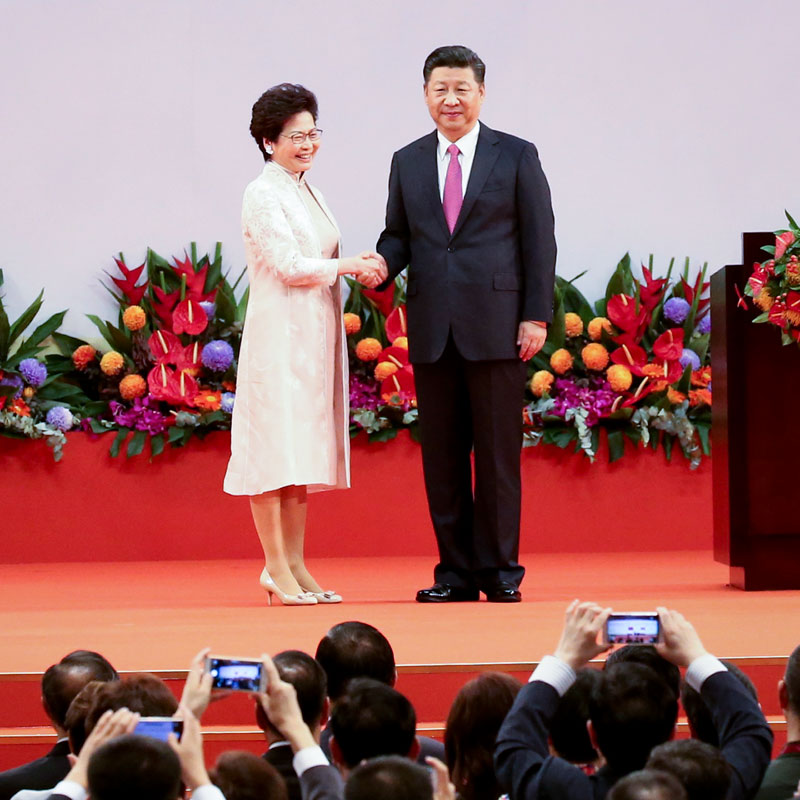President Xi Jinping shakes hands with Carrie Lam Cheng Yuet-ngor after she was sworn in as the fifth-term Chief Executive of the Hong Kong Special Administrative Region at the Hong Kong Convention and Exhibition Centre on July 1, 2017.
2017年7月1日,庆祝香港回归祖国20周年大会暨香港特别行政区第五届政府就职典礼在香港会展中心隆重举行。中共中央总书记、国家主席、中央军委主席习近平监誓香港特别行政区第五任行政长官林郑月娥宣誓就职后,与她握手祝贺。
Hong Kong is associated with the many memorable and remarkable moments in my more than 30-year career as a photojournalist. In the past two decades, since Hong Kong's return to the motherland, I've had several occasions to observe the city from up-close. While certain things seem to have remained unchanged, such as following the "one country, two systems" principle, some others have moved forward in keeping with the city's evolution into a modern, global metropolis.
I visited Hong Kong for the first time in June 1997. I witnessed the historic moment on the night of June 30, 1997, and recorded it on my film camera, capturing the ceremony at the People's Liberation Army Hong Kong Garrison's Central Barracks. On July 1, I was busy covering various events to mark the establishment of the HKSAR. I carried a telephoto lens and an aluminum ladder on my shoulder, running around all across the city. For a while I parked myself in front of the government headquarters and then stood in a queue at the old site of the Legislative Council. I also went to the stock exchange in Central.
In the next two and a half years I covered several important events in Hong Kong. I was sent here to capture the stock market crash during the 1997 Asian financial crisis, and again to photograph the impact of the Standing Committee of the National People's Congress' interpretation of Hong Kong's Basic Law regarding the right of abode case in 1999. I covered the outbreak of bird flu and many other breaking news and social events in the city.
I was transferred back to the Chinese mainland in 2000 but Hong Kong was never far from my mind.
Now I am back in the city, camera in hand, wandering around, revisiting the places I had last seen 17 years ago.
The old LegCo building, which now houses the Court of Final Appeal, is still popular with the Filipino domestic workers for their weekend gatherings. I saw more free newspapers at MTR stations but fewer newspaper stands at the Star Ferry Pier. While many new stocks have arrived in the market, the trading hall is smaller than before with fewer traders visible in action. Hong Kong's Hang Seng Index has climbed from 16,000-something points two decades ago to 25,000 points today.
The Chinese leader Deng Xiaoping's promise that the dancing and horse racing will continue in Hong Kong after 1997, under the "one country, two system" principle and the Hong Kong Basic Law, seems to have been honored.
And did I forget to add that many people I met on the street this time spoke fluent Mandarin?
Hong Kong today is indeed a city full of extraordinary vitality. Its current prosperity and optimism is owed to its international outlook, high energy, determination and competitive spirit.
作为一名摄影记者,我有幸用影像见证了香港回归祖国20年的不平凡。从1997年6月持公务护照进入香港,到7月1日零时用胶片相机在添马舰军营见证中英双方防务事务交接;从当年扛着长镜头、铝梯与当地媒体记者一起在特区政府门前、立法会和联交所等排队占位,到随后的两年半中报道亚洲金融危机中的港股暴跌、各界就“居港权”问题要求人大释法、禽流感暴发以及力所能及的突发、民生相关拍摄;从2000年被调回内地后十几年对香港的持续关注,到今天重回故地……香港,在我30多年的新闻摄影职业生涯中,是一段满怀情感、独特难忘的经历和记忆。
这几天来,我背着相机寻访、重温当年走过的地方。香港在《基本法》“一国两制”的框架下,港人治港高度自治,马照跑、舞照跳、股照炒……特区政府有了气派的大厦,立法会旧址廊道仍然是菲佣们周末休闲聚会的热选;联交所隔三岔五就会有新股上市,交易大厅面积变小了,现场交易员也寥寥无几,但恒生指数从我离开时的1万6千点已经攀升到今天的2万5千多点;地铁口路面上免费派发的报纸多了,而天星小轮码头的报摊报纸的位置却越来越不醒目了。对了,出去询路问事,会说“国语”的人越来越多,调儿也越来越标准了。
香港是个充满魅力的城市,既国际又多元、既竞争又包容。它背靠着祖国,活力洋溢,充满着希望!
